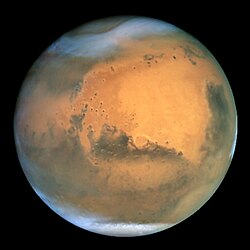Copernicus (krater)
| Marskrater | |
|---|---|
| Copernicus | |
 | |
| Egenskaper | |
| Koordinater | 48.84˚ S, 191.17˚ V |
| Medeldiameter | 301,83 km |
| Djup | 1.9 km |
| Uppkallad efter | Nicolaus Copernicus |
| Mars - ( ) | |
Copernicus är en nedslagskrater på planeten Mars namngiven efter den polske astronomen Nicolaus Copernicus.
Kratern har en diameter på ungefär 301 km.
Se även
Källor
- ”Copernicus on Mars” (på engelska). International Astronomical Union. 17 november 2010. https://planetarynames.wr.usgs.gov/Feature/1297. Läst 25 januari 2023.
| ||||||||||||||||||||||||||||||||||||||||||||||||||||||||
Media som används på denna webbplats
NASA's Hubble Space Telescope took the picture of Mars on June 26, 2001, when Mars was approximately 68 million kilometers (43 million miles) from Earth — the closest Mars has ever been to Earth since 1988. Hubble can see details as small as 16 kilometers (10 miles) across. The colors have been carefully balanced to give a realistic view of Mars' hues as they might appear through a telescope. Especially striking is the large amount of seasonal dust storm activity seen in this image. One large storm system is churning high above the northern polar cap (top of image), and a smaller dust storm cloud can be seen nearby. Another large dust storm is spilling out of the giant Hellas impact basin in the Southern Hemisphere (lower right).
Crater Copernicus on Mars. A daytime infrared image mosaic from the Thermal Emission Imaging System (THEMIS) instrument of the 2001 Mars Odyssey spacecraft. Width of the image is 500 km.


